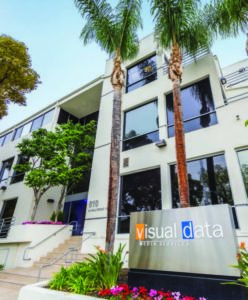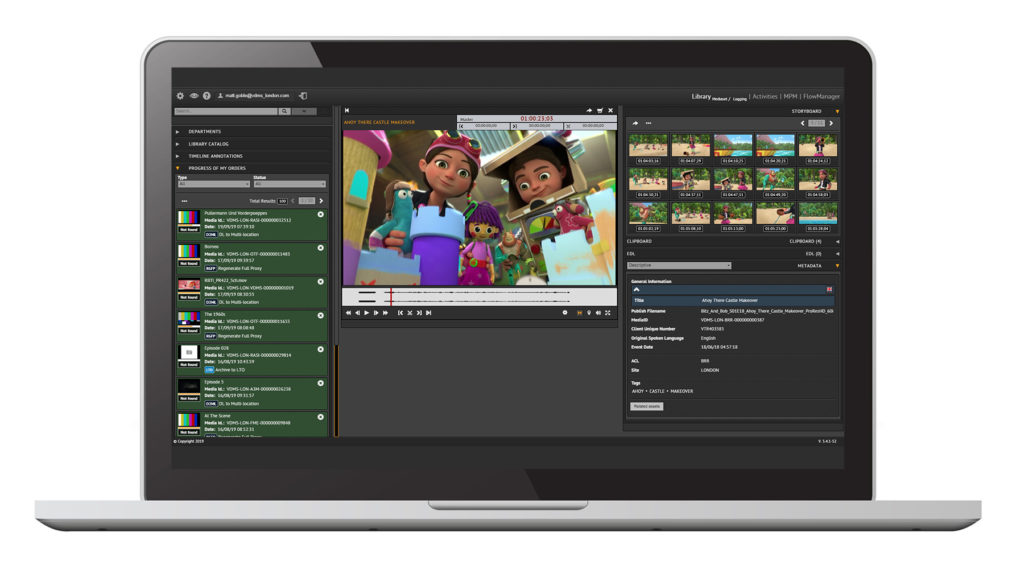What started in 1995 as a small editing facility in Burbank today has become one of the biggest multi-channel media management firms, with Visual Data helping content owners and distributors everywhere get the right content in the right format to the right place, and always on time. Kim Lawrence, EVP of Client Operations for Visual Data, spoke with MESA about the history of the company, how the company handled an unprecedented influx of content and associated delivery requirements during the pandemic, and why further development of AI and cloud-based solutions are a must to keep pace in a competitive localisation sector.
MESA: How did Visual Data first come about, what was the impetus for the company’s launch?

Lawrence: John Trautman, who began his career as an editor, founded the company in 1995 as a small editing facility in Burbank focused on creative excellence and client service. Seeing an opportunity to support a broader market, he added duplication and closed captioning to the roster of services. Twenty-six years later, with Trautman at the helm, Visual Data has grown into a globally recognised provider of digital media services, localisation, and entertainment supply chain solutions to some of the world’s most recognised media and entertainment brands.
Today, Visual Data is a leading independent end-to-end provider of digital supply chain services, with a state-of-the-art technology infrastructure and tailored workflow solutions designed to store, manage, re-purpose, localise and deliver premium film and episodic content across any platform. The company’s unwavering commitment to quality and service has made Visual Data a trusted partner and preferred vendor to the industry’s leading content owners and distributors and has earned them the coveted accolade of being a Netflix Preferred Fulfilment Partner (Americas) three times running.
MESA: Content management, distribution services, localisation, media formatting and workflows … Visual Data’s offerings in multichannel media management run the gamut. How does Visual Data make sure it stands out in all these areas, separating itself from competitors?
Lawrence: Visual Data has a deep 26-year history in post-production and media servicing and has grown over the past decade to support complete end-to-end media supply chain capabilities at a global scale. And while experience and scale may not, in themselves, be differentiators, what is different about Visual Data is the company’s commitment to quality and service — a commitment that has remained consistent throughout those 26 years and throughout the company’s growth.
During the recent pandemic, when ingenuity and resourcefulness was put to the test, the company took the opportunity to ground itself in a commitment to quality and service while further expanding technical operations to support scale. We invested in platform solutions and developed tools that enable both quality and quantity in workflow management — so clients are supported at every stage of the process and the integrity of the content is always maintained.
MESA: The pandemic impacted the localisation business — from subtitles to dubbing, closed captions to video descriptions — in ways like never before. How did Visual Data adjust to the way its in-territory localisation talent works, and how much has changed long-term in the way Visual Data delivers these services to platforms and broadcasters?
Lawrence: The unprecedented influx of new and library content and associated delivery requirements have created a clear demand for language servicing, and the impact is being felt across the entire media supply chain. The ripples from this, and how it will affect the business long term has been relatively unfelt in some areas while shifting the way the company does business for the foreseeable future, in others.
Because we manage Subtitling and Captioning services using connected platform technology, responding to global pandemic requirements quickly and with scale was a seamless process. We were able to get all of our people working remotely within twenty-four hours without impacting our clients, or our workflows. Demand had increased (almost overnight), but our technology was designed ahead of the media curve, so scaling was seamless, and importantly, quality was maintained.
Addressing requirements around dubbing and audio description, on the other hand, required more adaptation. Dubbing directors/actors/etc. were unable to record in-studio and with the impact of the pandemic varying so drastically from country to country, our teams were working in an entirely new world of project management. We designed a hybrid workflow model that allowed us to leverage remote dubbing where we could maintain the quality and integrity of the content.

Ultimately, our approach was to augment existing workflows with custom technology, rather than replace them, and create truly customised and scalable dubbing and audio description solutions.
As for long-term effects from the pandemic, we are seeing more of our customers looking to us to manage the full lifecycle of localisation projects. Increased demand for content means content owners have less bandwidth to service global markets as quickly as they need in order to support content hungry streaming platforms. With our expertise, we are uniquely equipped to handle the complexities and advancements that are rapidly occurring. Content owners and platforms are relying on us now more than even for broader lifecycle support — and we see this as the future of the industry.
We also see more attention being given to the creative element of localisation driven by consumer demand for higher-quality, in-territory and foreign language content. A poor-quality translation can ruin millions of dollars of investment in a production, which means language distribution and superior quality translations are now more valuable than ever. Our quality-focused workflow paired with our global scale puts us in a unique position to support our clients for long-term growth.
MESA: More content than ever before is being created and distributed by a growing number of platforms, broadcasters and networks. How does Visual Data keep pace with the complexities (formats, metadata, asset management, etc.) around delivering such large volumes of content?
Lawrence: As a result of the content creation boom driven by “binge watching” the bottleneck in our environment has shifted from an exercise in systems management to a workflow management challenge.
For a long time now, we have employed on-prem technology for high-performance storage, high-speed networking and transcode automation — well ahead of the demand curve. Our distribution platform was built to be agile enough to manage formats and metadata at scale, allowing us to keep pace with content creators, adapt quickly to changing distribution requirements and quickly address the increase in content and associated metadata.
The real complexity was in creating solutions that reduced touchpoints, allowing us to address information intake and format distribution in bulk with an exceptional level of efficiency.
Custom information exchange workflows gather metadata via client-side API integrations, then move through our automated metadata tool to package against unique platform specs. This deep investment in software development, aligning media assets with automation, enables delivery with accuracy and scale.
While the requirements of the past year have challenged us to think critically and creatively, we have come out of this with solutions that will allow us to iterate and support long-term growth for content owners and distribution partners.

MESA: What’s next for Visual Data, what advances and offerings can we expect from you next?
Lawrence: Visual Data has always been deliberate and thoughtful in our approach to development, innovation and expansion. This is why we have been able to maintain both technological, operational and service excellence throughout our growth.
As for what’s next, we recently partnered with Endeavor Capital allowing us to focus on further development of our AI and cloud-based solutions and expand our footprint to meet global demand for remastering and content distribution. We are continuing to scale services like Matchmaker, which offers clients a unique AI-powered scene matching solution for remastering and restoration. We have also invested deeply in building out our content management platform to support greater connectivity and simplicity in asset management for our clients.
We will continue to innovate and iterate as the industry moves with the current, but we will never shift our stance on our mission to provide an exceptional customer experience. It is that commitment which will continue to guide our evolution.

